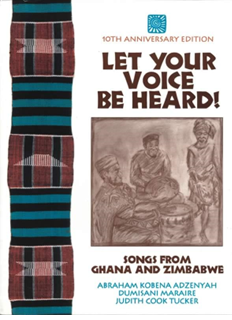Listen to this blog post by clicking the player below!
I’m back this week with the next edition of my Song of the Month series! This month’s song is “Sorida” a welcome song and hand clapping game from Zimbabwe.
I came across this song in one of my favorite resources, “Let Your Voice Be Heard!: Songs from Ghana and Zimbabwe” by Abraham Kobena Adzenya, Dumisani Maraire, and Judith Cook Tucker. I am really picky about the resources I choose to engage with and share because I do not feel that our music education publishers consistently give us high quality, well-researched resources that include the important information that is necessary for us to really understand the repertoire.
However, I highly recommend “Let Your Voice Be Heard” as a resource because it:
- Was created in partnership with culture bearers
- Includes authentic recordings of each song (authentic meaning from people of the cultures)
- Includes extensive information about the countries the songs come from, the cultures, and the languages used
- Includes extensive cultural information about the ways the songs and games are sung and played
- Includes helpful pictures, maps, geography, and other information to give a full picture to the songs throughout
Unfortunately, we often see “song collections” that are just a book of song notations without information about where the songs came from, from whom the songs came, how they are engaged with, or even what the purpose of the songs are. This leads music educators to just pick songs because they see notation on a page that they think will help students to learn a new concept or skill, but it doesn’t lead music educators to really listen to the music and engage with the song holistically in order to determine if it’s a song they would want to bring with their students.
I will continue to advocate for us as music educators to look beyond just “notes on a page” because music is so much more than notes! Besides the fact that music is aural, so you can’t really know how a song is supposed to be until you hear it, music is expression, it’s feeling, it helps us understand, it helps us process, it connects us, and it gives us joy.
When selecting repertoire and designing instruction, we must ensure that our instruction reflects the fullness and many facets of music, rather than just focusing on the notes.

Sorida: A Shona Hand Clapping Game & Welcome Song
“Sorida” is a hand clapping game from Zimbabwe’s Shona people. The translation of the first verse where the word “Sorida” is repeated, is a greeting term. In “Let Your Voice Be Heard!,” it is shared that “Sorida” is “similar in use to “jambo” in Swahili, or perhaps “shalom” in Hebrew.”
The hand clapping game can be played with children of many ages, in the book a couple different versions of the hand clapping game are given: a basic version and a more advanced version. In both versions, the children practice both physical and musical coordination as they are challenged to sing in one rhythm, but move their arms and hands in a different rhythm.
Teaching Ideas for “Sorida”
“Sorida” is a beautiful song with so many rich connections that could take learning in many directions.
In the general music classroom, “Sorida” is a great piece to explore melody & high, middle, low pitch, as well as the specific pitches “do,” “mi,” “so,” as the piece only uses those three pitches throughout in very predictable melodic turns.
Consider having your young musicians first learn the game, then lead them to identify the melodic contour kinesthetically, aurally, and then visually. Introducing the terms ‘melody,’ ‘pitch,’ ‘high, medium, low,’ would then be a natural follow up once they have internalized the melodic contour.
And remember: Culturally Responsive Music classrooms utilize a robust and multifaceted approach to teaching music that moves beyond just facts and skills. It’s not good enough to just learn the hand clapping game and the melodic concepts, remember that you must also bring in the full story of this piece when teaching this to your students:
- Learning about Zimbabwe – where it is located on a map, historical information, current events (one of the seven wonders of the world, Victoria Falls, is located in Zimbabwe!)
- Learn about the Shona people – their history and current events
- Making connections to other languages they may know how to greet, or say hello, to someone
- Learning about game songs and what they have in common across cultures and languages
- And more!
What other ideas do you have for “Sorida” in your music classroom?
I would love to hear what other ideas you have for how you could teach “Sorida” in your music classroom!
Share below or share on social media and tag me: I’m @ACuthbertson10 on Twitter & Instagram, and @ACuthbertsonConsulting on Facebook.
Also, let me know what you think of this post! If you haven’t already, be sure to sign up for my email newsletter where I send blog posts and other music ed resources and tips each week to help support you ensure all of your young musicians thrive.
Until next time,
Ashley
P.S. Did you like this post? Use the buttons below to share it with a music teacher friend!
